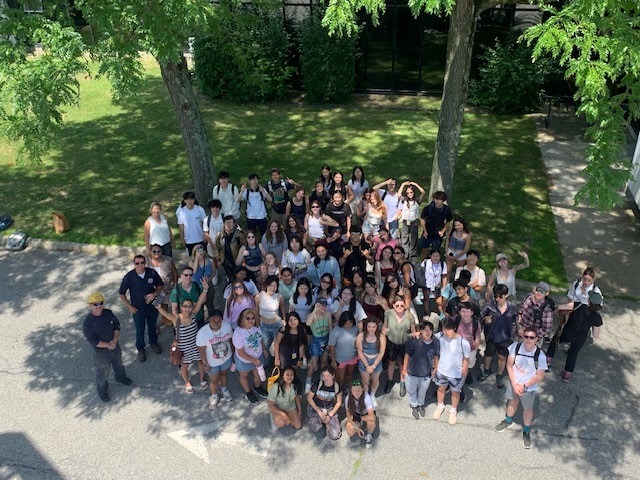A cohort of 60 students congregated in the Green Mountains of Vermont last summer to study and strategize solutions for climate change. They cross-referenced their passions and skills with the types of influence they could access as youth. They identified climate challenges in their own regions or communities. They wrote their plans, detailed their timelines and imagined their impact, and then presented their ideas to experts in the field for feedback. Then they returned to their cities and towns and started to put their projects into action.
We checked in with three of these students to see how their projects have unfolded. Their reflections reveal fundamental challenges and strategies for generating change amid an urgent global crisis.
Anna P., Vaishnavi S. and Katana K. attended the summer 2024 session of The Columbia Climate School in the Green Mountains, a two-week campus-based program for high schoolers interested in understanding climate challenges and leading solutions. At Green Mountains, students learn alongside like-minded peers and work closely with Columbia experts through lectures, fieldwork, activities and excursions. Ultimately, they create Climate Action Projects to be implemented in their own communities after the program ends.
Anna, a high school sophomore in Virginia, was fascinated when she learned about the Inflation Reduction Act (IRA) during a lecture from Green Mountains instructors. “I learned there are dozens of incentives, tax credits and rebates, but a lot of people aren’t leveraging them because it’s complex; it’s all on different websites.” Anna’s desire to rectify this issue inspired her Climate Action Project. She envisioned creating a website to empower users to access the benefits of the IRA through an incentive calculator, search tool and newsletter.

Vaishnavi, a high school senior, was already working with an energy manager in her hometown in Washington State, helping to identify solar-viable buildings in her county, when she arrived at Green Mountains. “Solar installation was something I really wanted to do, even if it was hard to do,” she says, when reflecting on the development of her project. She had already identified her passion, but was pushed by expert feedback during the program to consider the details of implementation. She continues to make progress on her Climate Action Project with the goal of installing solar panels on K-12 schools in her region.
Katana, a sophomore, has applied the lessons from the Climate Change Ideation and Climate Change in Your Community lectures during the Green Mountains program to her Climate Action Club at her school. While she originally wanted to replace plastic utensils in the cafeteria with reusable silverware, she soon encountered obstacles, including lack of community participation and financial feasibility—two important components in onboarding support for sustainability initiatives. She’s now focused on other cafeteria projects, including researching biodegradable utensil options and expanding the school’s composting capacity, which is currently limited to a single bin and few pick-up dates. In her words, “that’s not going to cut it for long-term change.”

Vaishnavi, too, ran into challenges. The solar approval process was time-consuming, and school officials’ responsiveness did not match her own urgency. “What I learned, as a youth, when working with state or city institutions, is that your priorities may not be the same as their priorities. Until I am in a position of power or influence where I can make decisions lickety-split… I’ve learned to be able to make my goals flexible and to take on the pacing of government institutions. The best way is to try to do what I can and give pushes while staying on their schedule,” she says.
Katana agrees. “When you’re trying to make change in a very fixed system, you’re going to run into a lot of problems.” She, too, recommends “striking that balance between being insistent but not too insistent.”
Still, all three students found ways to make progress. They’ve learned that change happens through collaboration. “Find people with influence who have the same goals and determination to get it done that you have,” Vaishnavi advises. She also suggests making clear goals: “Listing all the schools [with potential for solar energy generation] and having it in front of our eyes was more encouraging to know what our goal is, and now we just have to take the steps to get there.” She has set her sights on becoming an environmental engineer working in renewable energy.
Katana will continue to work with her Climate Action Club and has plans to take over the leadership of the club next year. She’ll push her school to do better: “Educational institutions want you to be well-rounded individuals, future leaders, good communicators. If they expect this of us, then they shouldn’t be surprised when we actually want to make change.”
Anna will launch her website aimed at demystifying IRA incentives, “Save Money, Reduce Emissions,” in the spring. She continues to look for ways to increase user traffic to the site, both through social media and through community relationship-building. Being in high school “is the power I think I have. There’s so much more I want to learn and have to learn. But it’s also one of my strengths, because I am not working full time and have time to write, meet people, and host meetings and tell them about the project,” Anna says.
“Young people have incredible power in the climate movement and are stepping up as community leaders and driving positive solutions forward,” says Laurel Zaima-Sheehy, assistant director of K12 and continuing education at the Climate School. “We want to support students in developing a framework with tangible next steps so their Climate Action Project becomes a reality. The goal is for the climate work to continue long after the program is over. This is the work of our lifetime!”

For more information about the Columbia Climate School in the Green Mountains program, please explore our website and FAQs. Sign up here for our pre-college mailing list to stay updated on summer and academic year offerings, or email us at learn@climate.columbia.edu.
Source link
Guest news.climate.columbia.edu

